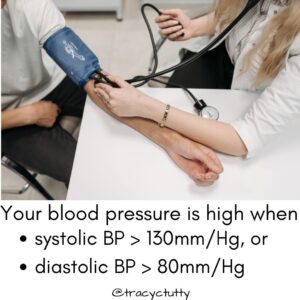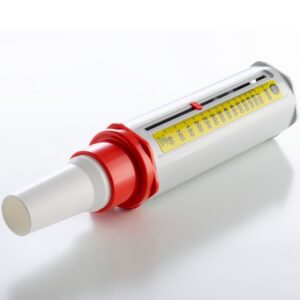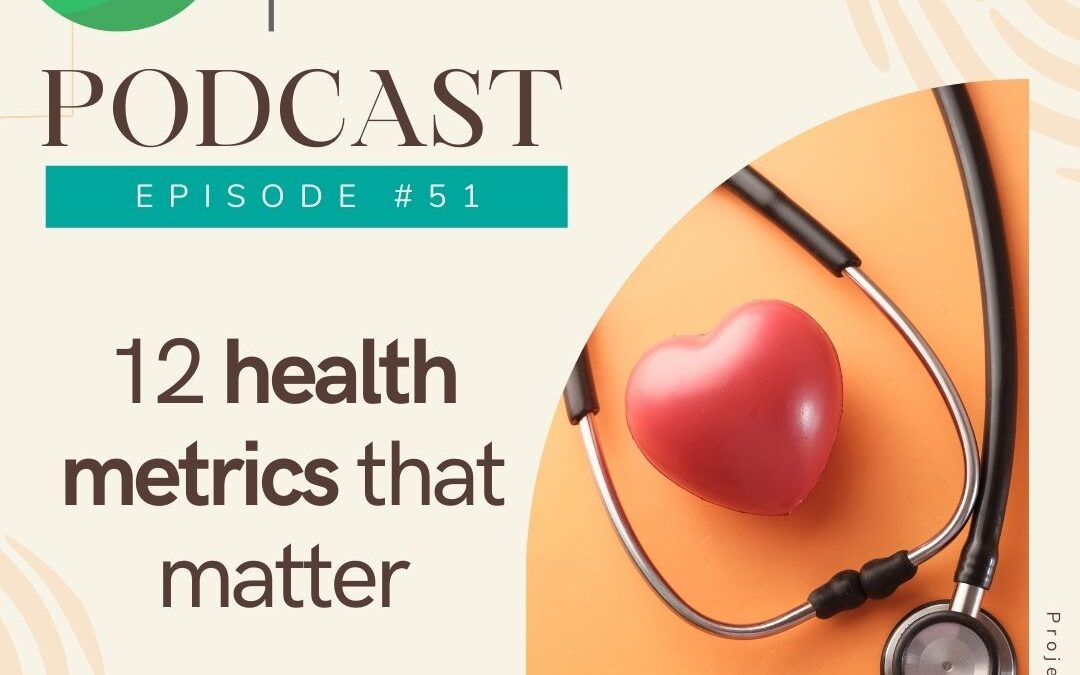Focus on one of these metrics each month and in a year you’ll be in great health
Blood pressure
Blood pressure is a measure of the amount of blood that’s pumped by your heart into the space in your arteries for your blood to flow through it. This is referred to as the amount of resistance. Systolic pressure measures the pressure when your heart beats. Diastolic pressure is a measure of the force in your arteries in between beats.

High blood pressure, also known as hypertension, is diagnosed when your systolic blood pressure is above 130mm/Hg (millimetres of mercury – mm/Hg), or your diastolic blood pressure is above 80mm/Hg, or you’re already taking medication to manage your high blood pressure.
Most people with high blood pressure don’t have any noticeable symptoms, and it’s a complete surprise when high blood pressure is revealed during a routine check-up. Some people do experience symptoms such as headaches, nosebleeds, red face or dizziness.
High blood pressure can be hereditary and associated with low nitrix oxide levels. It can also be caused by poor sleep, smoking, alcohol, or stress. Check out episode 25 for ideas on how to manage your hypertension naturally.
You can also have low blood pressure or hypotension. Low blood pressure is diagnosed when your systolic blood pressure is below 90 mm/Hg or your diastolic blood pressure is below 60 mm/Hg. It’s quite common to have no symptoms when your blood pressure is low. If you do have symptoms, they can include: feeling dizzy or lightheaded, fainting, blurred vision, nausea, tiredness for no known reason or finding it hard to concentrate.
Low blood pressure can be caused by emotional stress, feeling fearful or being in pain. Your blood pressure drops when you are dehydrated due to there being less blood to circulate.
Waist to hip ratio

Your Waist-Hip Ratio is calculated by dividing your waist circumference into your hip circumference.
Studies show you have a greater risk of developing heart disease, stroke, type 2 diabetes, and dying young if you carry more weight around your middle (an apple-shaped body) than if you carry more of your weight in their hips and thighs (a pear-shaped body).
This visceral fat surrounds your liver and other vital organs. It can increase inflammatory levels in your body resulting in high cholesterol, and increased blood pressure, and blood glucose.
The World Health Organization suggest the waist to hip ratio to aim for is:
- Less than 0.90 for men
- Less than 0.85 for women
Above 0.86 for women and above 1.0 for men puts you in the at-risk category.
The areas you want to be measuring are just above your belly button for your waist circumference and around the largest part of your hips over the butt cheeks for your hip circumference.
Heart Rate Variability
Heart Rate Variability or HRV, is a metric that measures the amount of time between each heartbeat and the variation in the timings.
Your body is constantly monitoring and adapting to your environment, what you’re thinking about, and what you’re putting in your body. It does this by automatically moving between your sympathetic and parasympathetic nervous system. These are often referred to as the one responsible for fight or flight and the one responsible for rest and digest.
One way of measuring this interplay is through heart rate variability. A high HRV score is a good thing, because it shows that you’re responding to the stimuli of your day by moving in and out of fight or flight, or rest and digest. But it’s all about the overall trend showing your HRV is on the up rather than focusing on one particular number.
Working with your HRV can help you dial in when is the best time to rest and recover and when is the best time to stretch yourself or push through that hard workout.
For more information on HRV, check out episode 32.
Peak flow

Peak flow is a way of measuring your maximum speed of air that can flow out of your lungs. The measurement is also called the peak expiratory flow rate (PEFR) or the peak expiratory flow (PEF). If you are asthmatic you will have done this many times and may even have your own peak flow meter.
Whilst you can google the normal range for your age and gender, the key thing to watch out for is any variation to what is normal for you. Take your peak flow reading each day at the same time for 2-weeks. This is your normal. Then compare your later readings to this normal.
If your strong out-breath is between 50% and 80% of your normal, it’s time to monitor it and seek advice from a medical professional. If your peak flow is less than 50% of your normal peak flow, then it suggests your airways have narrowed. This is the time to seek urgent medical attention.
Want to improve your peak flow reading? Providing you are close to the normal range breathwork, singing or swimming can be helpful.
Gum health

Healthy gums look firm and pink. There is no redness, tenderness or swelling and they don’t bleed when you brush or floss them.
Studies suggest an increased risk of heart disease in people who have gum disease. Poor oral health can also suggest high blood sugar.
Begin by visiting your dental hygienist or dentist for a check-up. They will let you know if your gums aren’t as healthy as they could be.
A build-up of plaque is the main contributor to gum disease. However, there can be other contributors:
- Hormonal changes during pregnancy, puberty, menopause can increase gum sensitivity.
- Diabetes reduces the body’s ability to use blood sugar so you may be at greater risk of developing cavities
- Saliva protects our teeth and gums so some medications which reduce saliva production or flow
- Smoking and poor oral hygiene habits such as not brushing and flossing each day
Eye Pressure
Measuring eye pressure is one of the key tests performed by your optician or ophthalmologist as it can be associated with the onset of glaucoma. Eye pressure is measured in millimetres of mercury (mm Hg). Normal eye pressure ranges from 10-21 mm Hg. Ocular hypertension is an eye pressure of greater than 21 mm Hg.
Stool consistency

Your stool should be soft, well formed and easy to pass.
No pushing or straining is needed and it comes out completely.
It’s an easy to manage log rather than rabbit pallets.
You’re going for a brown colour although this can change if you’ve eaten something like beetroot. There should be no blood when you go to the toilet unless your doctor has confirmed the presence of hemorrhoids. You should be passing a solid stool at least once a day. More than 3-days without a bowel movement and you are in the constipation range.
The Bristol Stool Chart is the most common visual aid when describing your stool. It provides 7 types of stool from hard pebbles when you are very constipated all the way through to the other end of the spectrum
What can cause changes in your stool consistency or frequency?
- Stress
- not drinking enough water
- inadequate fibre intake, or
- food intolerances are the most likely causes.
- Some health conditions such as an overractive thyroid, IBS or IBD, depression, or Parkinsons Disease can also affect your bowel function.
Generally speaking if anything changes in your own typical bowel function and you’re not sure why, get it checked by your Doctor.
Happily walk 5km

We need a level of fitness and resistance to keep everything ticking over. If you struggle to happily walk for 5km, start at a smaller distance. Make it fun by chatting with a friend, walking the dog or joining a walking group.
Easily get up from the floor
Maintaining our ability to easily get up from the floor in key to ensuring independence as we get older. It’s all about keeping your legs strong, your core engaged, being coordinated, flexible (not the super bendy yoga ninja type) and having good balance.

The way to measure this is through the no-hands test.
Sit cross legged on the floor and get up from the floor without using your hands.
Don’t do this if you have dodgy knees, advanced arthritis, or balance issues.
If you struggle with this, here are three exercises to add to your daily.
- The lunge where you stand with your weight evenly distributed over both legs. Step forward with one leg and the knee of the other leg dips to the floor. Make sure your knees are not extending over your toes in the front leg. Hold for 3 seconds and step back to your starting position. Repeat with the other leg leading the way. As an advanced option try a lunge on an uneven surface such as a bosu or balance ball. Alternatively turn your lunges into walking lunges. If you’re starting small, use the wall.
- Hamstring stretch. There are lots of options for this one. My favourite is lying on your back with a strap over your foot. Gently pull the strap forward until you feel a nice gentle stretch. Hold for 30-seconds and repeat with the other leg.
- And lastly, everyone’s’ favourite, the plank. This is all about engaging your core so you don’t hurt yourself. As you’re already on the floor stretching your hammies, roll onto your front. visualise your belly button reaching towards your spine and zip up your pelvic floor. Get into a push up position and hold for 2-minutes. Start with 20-seconds and build the time up from there.
Breast examination
October is Breast Cancer Awareness month. Breast cancer affects men and women. Finding an anomaly early is your best chance of recovery so make sure you know what normal looks like for you.
Just because you have an inverted nipple, it doesn’t mean there’s an issue. If you were born with an inverted nipple or two then that’s your normal. If your nipple suddenly moves inwards, that’s not normal for you and it’s best to get it checked out for peace of mind if nothing else.
Here’s how to do a self examination
- Stand in front of the mirror with your hands on your hips and notice what your breast normally look like. Check for any skin puckering, redness, a rash or a nipple that has moved inwards when it’s normally facing outwards
- Raise your arms up above your head and check again. Is there any fluid coming from one or both nipples?
- Now it’s time to palpate your breasts. Use your opposite arm to feel each breast (left arm palpates right breast for example). Use small firm circular strokes. Think of a clock face. Start at 12 and move all around the face of the clock. You’re checking for any unusual lumps or bumps. Don’t forget to check all the way into each armpit.
- Lying on your back, palpate using your opposite arm to feel each breast (left arm palpates right breast for example). Use small firm circular strokes. Think of a clock face. Start at 12 and move all around the face of the clock and don’t forget your armpits. You’re checking for any unusual lumps or bumps.
Lumps and bumps are normal, especially if you have large breasts. So don’t worry if you find one. If it seems a bit weird or it changes shape or size between examinations, check with your doctor for peace of mind if nothing else.
Blood sugar
Yor blood sugar level is a good indicator of insulin sensitivity or diabetes. You can do this test yourself or at a laboratory after speaking with your doctor.
There are a variety of tests. The Centre for Disease Prevention has a great table of the different tests and the ranges for normal, prediabetes and diabetes.
If you find your blood sugar is on the high side, try increasing your fibre intake. Ensure you are well hydrated and add some additional exercise into your life. Nothing fancy, just a 30-minutes walk each morning can help. Research low glycemic foods.
The glycemic index ranks foods according to how they effect your blood sugar levels. Foods with a measure of less than 55 of considered to be low glycemic foods. Low glycemic foods tend to be less processed, have more fibre and more complex sugars in them. They require a bit more processing so don’t trigger the typical insulin spike that you see with high glycemic foods.
HDL to LDL ratio
HDL and LDL refer to the different types of cholesterol that you have high density lipoprotein and low density lipoprotein. Your body needs cholesterol so not all cholesterol is bad but we prefer the high density variety.
HDL helps your body to get rid of excess cholesterol so it’s less likely to end up in your arteries. LDL transports cholesterol to your arteries, where it can collect in your artery walls. Combine that with some systemic inflammation and you increase the risk of heart disease or stroke.
To calculate your cholesterol ratio, divide your total cholesterol number by your HDL cholesterol number. So if your total cholesterol is 5.2 mmol/L and your HDL is 1.3 mmol/L, your ratio would be 4-to-1. The higher the ratio, the greater your risk of developing heart disease. A ratio above 6:1 is considered high risk.
Our goal is a ratio of 3.5:1 or lower.
If your ratio is not optimal, adjust your diet by adding in more fibre rich fruit and vegetables and move a bit more. There are also some wonderful herbs that can support heart health and cholesterol management.
12 health metrics that matter

So there you have it. Something for each month of the year.
Pay attention to these 12 things and in a year’s time you’ll be in good shape

